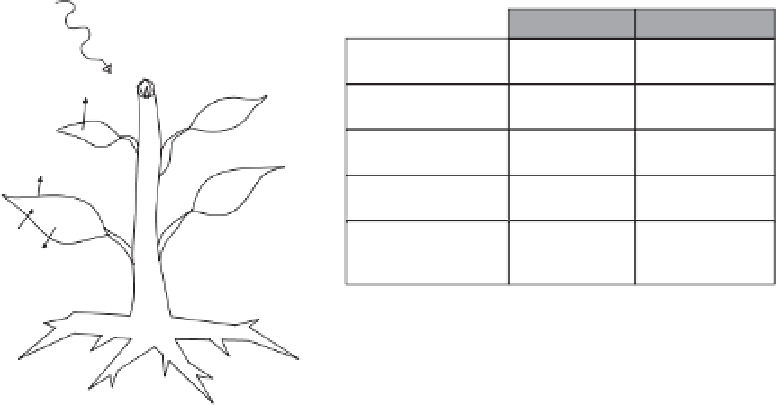Agriculture Reference
In-Depth Information
Solar radiation
Sources of:
Sinks of:
Assimilates,
water
Apex
Hormones
Assimilates,
water
Young leaves
Hormones
Water,
assimilates
Adult leaves
Carbohydrates
Water vapour
Stems and roots
(Reserves)
(Reserves)
CO
2
Water, hormones,
mineral elements
Roots
Assimilates
O
2
Fig. 6.1.
Schematic representation of the organization and relationship between the various organs in a
plant (adapted from Berninger, 1989).
the product in different grades and refer-
enced to the surface unit, relies on the effi-
cient use of incident solar radiation by the
crop, which in itself, requires appropriate
plant density and properly arranged and
managed leaf canopies to achieve an opti-
mal economic profit.
and nutrient supply which cover the crop
requirements,
performed
with
proper
periodicity.
When water and mineral supply is
achieved by drip irrigation, the root system
develops less than in the case of surface irri-
gation, and therefore the aerial part:root
ratio is higher. Consequently, drip-irrigated
plants can allocate more assimilates to the
upper organs which are the parts of interest
in the common vegetable crops, but these
plants are more sensitive to an accidental
water deficit.
Transpiration is the evaporation of
water by the plant, mainly through the sto-
mata of the leaves. The energy required to
evaporate the water basically comes from
the solar radiation; therefore, transpiration
is directly related to solar radiation. In
heated greenhouses, the energy supplied
may also contribute to transpiration. In
Mediterranean greenhouses, the irrigation
water requirements to cover the demand of
the vegetables crops range from 0.5-1 mm
day
−1
in winter to 4.0-5.0 mm day
−1
in
unshaded greenhouses in the summer
(Castilla, 1995). With intermittent surface
irrigation (when a single irrigation could
apply more than 10 mm of water), the use of
cold water must be avoided, as it may
induce undesirable cooling of the rhizo-
sphere (Berninger, 1989).
6.2
Physiological Functions
and Growth
The main physiological functions involved
in the growth of a plant are: (i) water and
mineral element absorption by the roots;
(ii) water vapour transpiration through the
leaves; (iii) photosynthesis; and (iv) respira-
tion (Berninger, 1989).
Water absorption is influenced by cli-
mate conditions (radiation, temperature),
plant conditions (water stress) and soil
conditions (water availability, aeration).
To optimize water and mineral element
absorption it will be necessary to have:
(i) an appropriate soil or substrate (well
drained, able to store the required amounts
of water and oxygen to ensure a sufficient
availability between two consecutive
irrigation episodes); (ii) a balanced soil
solution (with an appropriate concentra-
tion of nutrients for the crop, and ade-
quate salinity and pH); and (iii) water





